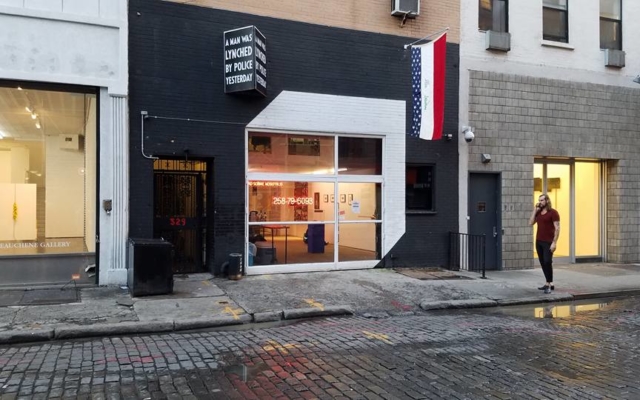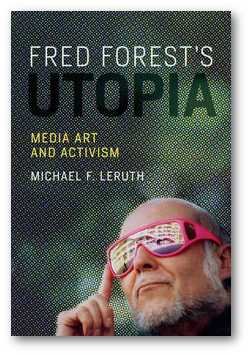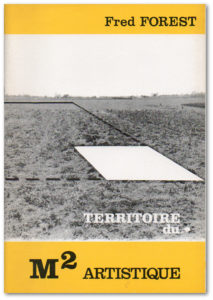
FRANCAIS
ENGLISH

Hello, I am a French artist who once sued the Pompidou Center for its lack of transparency and I have now decided to honor the Center once again by making it the subject of an exhibition in New York City!
The counterattack of the Square Meter Territory.
We have never seen anything like this! Just a few months after being invited to have a major retrospective of his work at the Pompidou Center in Paris, an artist is returning the favor by making the Pompidou Center the object of an exhibition in New York! I, Fred Forest, am that artist.
As both an artist and a concerned citizen, I am holding this exhibition in a spirit of objectivity and parody. Objectivity insofar as I am content to present the relevant documents with minimal commentary and leave it up to the public to interpret those documents as it sees fit and to arrive at its own conclusion. Parody as is evident the title I have chosen, in a nod to a cult series known to all: “The Territory of the Square Meter Strikes Back”.
As in Star Wars, there is a luminous and obscure FORCE, which artists, like the JEDI, know how to use in ways that defy logic to resist the henchmen of an abusive and usurping power. The force is a principle of metaphysical, ethical, and social equilibrium that exerts itself on the entire universe and against museums, art fairs, collectors and the market in particular. It is treacherous work that one would have to be crazy to do, and no Jedi is ever guaranteed success. No matter what the future holds, it is the fight that matters here and now! So let us fight!
Whoever you are, wherever you live, and however you get here (plane, subway, horseback, on foot, or online), do not miss this exhibition. Depending on your views, you will find it either messianic and consciousness-raising or ironic and amusing. This exhibition foretells of changes in the art world that will be either trivial or irreversible!
In this pivotal moment in history when humanity is confronted with drastic changes that are being felt the world over in every field of human endeavor, you have the choice between being a passive “viewer,” as you are in front of a Duchamp, or a committed “participant” and agent of change. This exhibition presents a dozen actions that demonstrate my lifelong commitment to unsparing institutional and political critique, giving the most attention to the most recent one: the Territory of the Square Meter’s epic struggle of resistance against the Centre Georges Pompidou or, to be more exact, those responsible for its turn to the DARK SIDE. May the Force be with us.
F.Forest
CURATOR Michaël Leruth
Associate Professor of French and Francophone Studies at the College of William and Mary
Author, Fred Forest’s Utopia: Media Art and Activism (MIT Press, 2017)
https://mitpress.mit.edu/books/fred-forests-utopia
Curator’s Note
Fred Forest has been an outsider and rebel all his life and he is not going to stop now. Not because he is eighty-four years old. Not because it is high time for him to step back and smell the roses as his work becomes the subject of a growing number of scholarly articles, doctoral dissertations, conference presentations, books, and exhibitions the world over (e.g., Brazil, United States, France, Bosnia, Germany). And certainly not because he has just been treated to what any other French artist would consider a consecration: a major retrospective at the Pompidou Center in Paris (July 12 – August 28, 2017). For Fred Forest, being a rebel is not the same as being a terrorist: someone who seeks to stir up discord through sensational acts of destruction. And it is not the same as staging outrageous publicity stunts: cultivating the branded persona of the “bad boy” for the sake of fame and fortune. It is about a passionate, uncompromising, and utopian commitment to freedom. About carving out small spaces, or liminal moments, of freedom—for freer uses of modern means of communication, freer perspectives on society, freer forms of human interaction, freer ways of making and sharing art—in a world where the institutional powers that be would have things otherwise. More controlled. More respectful. More hierarchical. More profitable. More predictable. More passive. More distracted by spectacle. More conservative. More appropriate. More structured. More carefully curated. Think of Bakhtin’s theories on the subversive nature of carnival. Think of Michel de Certeau’s analogy of poachers and trespassers who maneuver artfully in the proprietary cultural and urban spaces (lieux propres) shaped by and for the powerful. Think of Hakim Bey’s temporary autonomous zones. Or think of Forest’s own definition of sociological art, a movement he helped to pioneer: neither sociology nor art, but a form of radical sociological praxis that operates under the cover of art.
It is no wonder, then, that Fred Forest’s artistic practice has often involved criticism of—and conflicts with—institutions of power. Beginning in the 1970s, Forest targeted institutional forms of power in the media, society, politics, art, and the economy with participatory experiments he described in terms of “trans-media events.” He first attracted attention as the “artist who pokes holes in media” (Vilém Flusser) in 1972 by inserting small blank squares in the pages of the prestigious Parisian newspaper Le Monde which he asked readers to fill with their own content (Space-Media: 150 cm2 of Newspaper), thereby turning a static and elitist type of media into a more interactive and democratic one. In 1973, he led a team that conducted an experiment in a retirement home designed to give back to the residents the power over their own image in a society obsessed with youth and productivity by organizing them into groups that made their own short video documentaries about their lives in and outside of the home (Senior Citizen Video). Later that same year, Forest was arrested by the Brazilian secret police (DOPS) after he staged a mock street demonstration (The City Invaded by Blank Space), for which the marchers carried conspicuously blank signs, as part of a series of interventions in conjunction with the Bienal de Sāo Paulo. He returned to Sāo Paulo and its Bienal in 1975, uninvited, to stage an alternative exhibition that offered a whimsical and critical deconstruction of the official Bienal in real time—in a space adjacent and hard to distinguish from the official exhibition venue—while treating the Bienal in progress as if it were the artifact of an ancient civilization (Biennial of the Year 2000, 1975). In 1977, he targeted the information and publicity-dependent speculative practices common to both the art and real estate markets by forming his own real estate promotion company and offering for sale at a public auction miniscule parcels of undeveloped rural land advertised as “artistic” in nature (The Artistic Square Meter)—an operation that led to a police investigation on suspicion of fraud and false advertising and was banned in its original form by the public prosecutor’s office.
These rebel tactics did not subside as Forest grew into a “mature” and “serious” artist. On the contrary, they continued in the 1980s, 1990s, and 2000s—becoming more sophisticated and more audacious in some instances. One example is Learn How to Watch TV by Listening to the Radio (1983), for which Forest assembled an ad hoc network of independent FM radio stations (only recently legalized in France) to broadcast alternative audio to go with the official visual content of French television. Another is his renegade campaign for the presidency of Bulgarian national television in 1991 (Fred Forest for President of Bulgarian Television), for which he staged a surreal motorcade in the streets of Sofia and very nearly persuaded the incumbent to debate him on live television on the merits of his proposals for a more “utopian and nervous” form of TV. More recently, there was The Traders’ Ball (2010), which satirized the predatory speculative folly that caused the financial crash of 2008 through an installation of boogying traders (appropriately hollow mannequins) in Midtown Manhattan and a virtual dance party for avatars in Second Life. The critical gesture for which Fred Forest is most famous, however, is one that he does not even consider part of his artistic oeuvre per se: his citizen’s court case against the Pompidou Center (1994-98) over the lack of transparency and alleged insider deal making in the prestigious institution’s acquisitions procedures—a case which he ultimately lost on appeal before the Council of State but which gave him a celebrity’s platform on which to denounce the corruption and social insignificance of institutional contemporary art and also sealed his fate as a persona non grata of the French art establishment.
So, what, then, is one to think of the 2017 Pompidou Center retrospective that is the subject of Forest’s current counter-exhibition? Was it a gracious (or grudging) peace offering on the part of an institution finally giving a major figure in French contemporary art his due? Was it a cynical ploy designed to exploit and ultimately neutralize a still fiery dissenter? Forest had staged an attention-getting protest performance at the 2012 Vidéo Vintage exhibition at the Pompidou Center, having himself bound from head to toe in “vintage” Sony Portapak videotape and then cut free by the public to call attention to his exclusion from the exhibition. There is much to like in the thoughtful and well-furnished exhibition curated by Alicia Knock. It did a good job of presenting Forest’s pioneering achievements in video, media, and telecom art (although it ostensibly left out his experiments in Net Art after 1995). It also highlighted the subtle beauty of the content and artefacts associated with many of Forest’s actions—the result of a refined esthetic sensibility often overlooked by critics, but not lost on Pierre Restany, who considered Forest a worthy successor to Yves Klein’s poetic treatment of voids. Finally, it justly focused on the notion of Territory as the unifying principle of much of Forest’s work, as is evident in the retrospective’s title, Fred Forest: Les Territoires. Indeed, Forest has been thinking in terms of utopian territories ever since he started inserting small blank spaces in the media in the early 1970s. The exhibition did a particularly good job of charting the genesis of the Territory of the Square Meter from its conceptual origins in 1977 to the creation of a simulated independent state based at Forest’s home in Anserville (50 km from Paris, in the Oise department) in 1979-80. This long-running playful experiment in DOI sovereignty/imagined community falls into the category of “intimate bureaucracy” (Craig Saper), a recurring practice in modern and contemporary art, from Surrealism to Fluxus: an artistic, parodic, and utopian détournement of the bureaucratic structures of modern society. One could become a citizen of the Territory by purchasing a subscription to a square meter section of the grounds. Forest served as the Artist-President for Life and transformed the rooms on the ground floor of his renovated eighteenth-century manorial outbuilding into a most unusual seat of government. While the retrospective did not adequately examine the subsequent virtualization of the Territory leading up to its transposition in Second Life (e.g., The Experimental Research Center of the Territory, 2008), it did offer visitors an opportunity to visit and explore the Anserville site through a VR interface.
Its redeeming qualities notwithstanding, the retrospective was also problematic in a number of ways. The artist explains his grievances against the Pompidou Center on this website and throughout this counter-exhibition. They are worthy of consideration and are not trivial since they include allegations of discriminatory treatment and broken promises as well as the broader issue of who ultimately controls the message in such events, the artist or the institution (cf. Rebecca J. DeRoo, The Museum Establishment and Contemporary Art: The Politics of Artistic Display in France after 1968). For me, there was also a more basic problem: the retrospective betrayed the rebel spirit of Territory—and could not do otherwise given its institutional logic, no matter how “successful” it was according to other (institutional) criteria. Forest’s Territory, which is synonymous with his notion of a “realistic utopia” and extends far beyond Anserville to include virtually everything he has done as an activist artist, is not something that can be pinned down, put on display on walls and under glass, catalogued, and reconfigured so as to conform neatly to the academic categories of art history (Nathalie Heinich’s concept of the “tradition of transgression” included). It is a living and unstable entity that only exists fleetingly and episodically via the way that participants in Forest’s various projects interact with and through the temporary utopian interfaces he sets up. Above all, it is a rebel enclave, open to all nomads, forever insoumis (i.e., unsubdued and refractory). Forest sensed rightly that the retrospective represented an attempt to colonize the Territory, to make it part of the Empire of Art. So he resisted. He resisted first by staging two unruly and eccentric participatory events in the exhibition space at the Pompidou Center. He continued to resist by criticizing the Center relentlessly in social media both before and after the exhibition’s closure. And he resists today through this counter-exhibition at The White Box. There is no bitterness or ingratitude in this resistance. His act of resistance is performed joyfully and can be considered his ironic way of thanking the institution by giving it and its public a true taste of the Territory. For anyone who knows Fred Forest, this unceasing resistance was the only outcome possible.
Fred, may the Force be with you!Michael Leruth
Prof. Michael Leruth talks to us about his latest book,
“Fred Forest’s Utopia : Media Art and Activism,” published this year by MIT Press.
Le M2 de Fred Forest par Sophie Lavaud
http://www.sophielavaud.org/?p=2191
DOUBLE STANDARD ON THE PART OF THE MANAGEMENT OF THE POMPIDOU CENTER AND DISCRIMINATION AMONG ARTISTS EXHIBITED IN DIFFERENT CONDITIONS DEPENDING ON WHETHER THEY ARE THE FAVORITE SONS AND DAUGHTERS OF THE SYSTEM OR PARIAS COMING FROM ELSEWHERE …
CONDITIONS IMPOSED ON FRED FOREST
1. Reduction in the duration of the exhibition by five weeks in comparison with exhibitions of the same type that have traditionally been organized for an artist’s retrospective.
2. Rescheduling of the exhibition during the middle of summer instead of what was originally agreed to.
3. The exhibition was relegated to the basement level of the Center even though all major retrospectives devoted to artists worthy of the honor are staged on the 6th floor, the “noble” space that offers genuine recognition to an artist.
4. After being asked to come to the Center some time before the opening of the exhibition for a recording intended to be used during the celebration of the Center’s 40th Anniversary, the artist was disappointed to find he had been a victim of censorship: his sequence had been cut at the last minute without explanation or apology.
5. Following the refusal to give the artist a contract (letter of intent), said artist had to wait in limbo for two years and six months from the moment he was officially notified about the decision to hold the exhibition before any concrete steps were taken to planning for it. This was detrimental to the proper preparation of the exhibition.
6. In the absence of this legally binding document, the artist was unable to take the necessary steps to find sponsors, who were indispensable considering the lack of funding from the Pompidou Center. Although this is supposed to be its purpose, the Center’s patronage and development department categorically refused to have any contact with the artist. This was also the case of the publications department, responsible for publishing catalogues.
7. The grid-like layout of the Territory, which should have been traced on the pavement of the Place Georges Pompidou according to the original project agreed to in principle, was never carried out, thereby depriving the artist of a key presence outside the building for involving the public.
8. For the first time ever since the creation of the Pompidou Center, an artist given a retrospective was not given a printed catalogue published by the Center. Once the artist had found the funds needed to print one on his own, both the Director of the Pompidou Center’s National Museum of Modern Art (MNAM) and the exhibition’s curator refused to write a preface and introduction, as is normally done.
9. Compared to the initial project, duly accepted by the Center, the Institution did not make sufficient resources available to carry out the project in spirit or form.
10. The retrospective was grossly incomplete because the last 20 years of the artist’s activity, certainly the richest insofar as they encompass his pioneering work on the Internet and Second Life, were totally overlooked.
11. Given the public success of the exhibition, acknowledged by none other than the General Secretary of the Center himself, and in consideration of timing during the summer—a period of the year when many people who might have been interested were on holiday—the artist made a legitimate request for its extension or reprise at a later date; however, neither of these suggestions was accepted.
12. Total dereliction of duty on the part of the exhibition’s curator, who was noticeably absent during its preparation as well as during the staging of the two collective performances that were planned for the project a long time in advance.
13. A further failure on the part of the curator to make inquiries about the exhibition’s travelling to a foreign institution in spite of contacts that were obtained for her by the artist.
14. The curator is also responsible for cancelling a joint project with the National Museums of Canada and the BRAVO Association that the artist had himself initiated.
15. The cherry on the cake: the invoice issued by the Pompidou Center, which the curator personally delivered to the artist in an attempt to force him to pay for the museum’s security guards for the duration of the exhibition, the staff members on site to coordinate things, a number of insurance premiums, and finally the cost of setting up the installations involving the Virtual Reality and network actions. Why not also the buffet served on the day of the inauguration (if there had been one)? Obviously, the artist will never accede to this demand for payment (see the attached copy of the document in question).
16. Also left uncovered by the Center were the costs relating to Michael Leruth, an academic specializing in the artist’s work, who came from the United States in order to take part in a round table discussion of the artist’s career with the curator.
17. Finally, the head of the Center’s communications department hit rock bottom with the preparation of the artist’s network action. Incapable of anticipating or appreciating how the institution’s image on the international stage would benefit from a large-scale operation using the Internet, he preferred to put the key under the mat and go off on holiday, designating two subordinates from his department to take over. I did not have the opportunity to meet the two individuals in question even once, despite my many attempts.
18. To end on a more positive and personal note, I would like to say that I am very pleased to have been able to stage this retrospective exhibition in spite of the innumerable problems which I sadly had to face. Difficulties are part of the game and I consider myself privileged because many other artists will never have this chance! Nevertheless, I must confess that the existence and success of this exhibition were both due solely to the artist and his capacity for resistance against the Institution’s calculated arbitrariness and hypocrisy.
Now it is time for younger artists to take back power from the Institutions. I have just shown that it is possible.
Letter of “Discharge of Liability” that the Pompidou Center, through his curator, wanted to make the artist sign—something that he has steadfastly refused to do in spite of the implied threats of cancellation that were left hovering over his exhibition.
Exhibition “Fred Forest – Retrospective,” Pompidou Center, Forum -1, 12/07/2017 – 28/08/2017
Discharge of Liability
I, the undersigned, Fred Forest, as artist and lender of all of the works, installations, and documents listed below, have been informed of the security conditions of the Forum -1 space without the presence of security and reception personnel. I therefore declare myself to have been informed of the risks incurred by the items presented for the duration of the exhibition, including assembly and disassembly.
The following works and installations will be presented in the exhibition:
– […]
– This is a non-exhaustive list. This release covers all items lent by me, whether transported by agents of the Pompidou Center, by my own means, or any other method of delivery or return organized by me. I accept that all items are not insured against theft or deterioration during transportation back and forth, assembly/disassembly, and presentation to the public; and that they cannot be the subject to any compensation from the Pompidou Center or its insurer in the event of disappearance or total or partial deterioration.
However, a precise inventory of the items will be made by the Pompidou Center at the opening and closing of the exhibition.
Accordingly, I am releasing the Pompidou Center from any liability in case of disappearance or total or partial deterioration of the items and I expressly waive any claim to compensation or restoration due to total loss and/or depreciation resulting form any natural or manmade disaster that could affect them for the duration of the exhibition at the Pompidou Center, or during round-trip transport and assembly/disassembly operations.
Enacted in Paris, [Date] 2017, [Signature] (with the mention “Read and approved”)
… some pictures of the exhibition space :
the whitebox gallery in nyc

White Box (WBX) is a non-profit arts organization located in the Lower East Side – Chinatown. Founded by a group of international artists and curators in 1998, WBX’s mission continues to follow the core of its original mandate, which is to develop and present a dynamic roster of engaging programs that give visibility to thought-provoking and socially relevant art. WBX is committed to not only showcase experimental work by local, national and international emerging and/or established artists, but to also spotlight those that are underrepresented, providing them with the opportunity to connect with diverse audiences.
| LOCATION
To get to the White Box Location: Subway Bus |
CREDITS
Corinne FHIMA Sophie LAVAUD |











